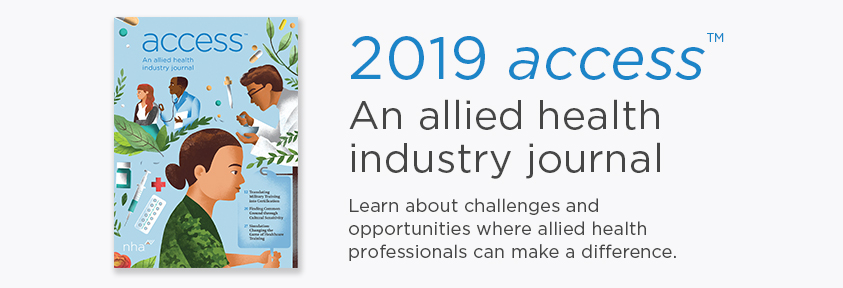The field of medical assisting is on an upswing. Job postings per medical assistant (MA) completion more than doubled between 2011 and 2014, and the faster-than-average employment growth is likely to continue over the next decade.1,2
Healthcare system redesign strategies, which encourage providers to work at the top of their licenses, are opening up opportunities for medical assistants to engage in higher-level responsibilities, driving greater job satisfactionamongst medical assistants working in these roles.3
And some healthcare employers are now offering signing bonuses and career laddering opportunities to attract and keep medical assistants in their organizations. Despite positive growth trends, there are some challenges that make this a pivotal moment for the profession.
Employment outlook for medical assistants
According to the Bureau of Labor and Statistics (BLS), employment of medical assistants is expected to grow 23% from 2014 to 2024, much faster than the average for all occupations, which are expected to grow around seven percent.2
Not only are employment opportunities growing, but the number of MA completions is declining—further growing job opportunities for medical assistants.
Davene Yankle, nurse manager of clinical development for the Ohio Health Physician’s Group, said her organization is seeing MA shortages. “We are seeing a shortage in both primary care practices (PCPs) and specialty practices. Due to shortages, specialty practices are using administrative assistants in place of MAs, and in orthopedics we are using athletic trainers in place of MAs. In PCP areas, we are hiring more LPNs when we can find them.”
Pamala Smith, BSN, vice president chief nursing executive with Advocate Medical Group, said that they are also experiencing a shortage of medical assistants. “There are greater challenges in recruiting experienced medical assistants,” said Smith.
While MA shortages are beneficial for those seeking employment, the shortages do create challenges for employers. What can employers do to both find and retaingood MAs?
Employers can often increase the number of MA candidates they receive by partnering with schools in the following areas:
- Student mentoring programs
- Advisory panel participation
- Performing mock interviews on students during capstone classes
- Being an active participant in the school’s externship program
Partnering with an educational institution provides both students and employers with an opportunity to get to know each other and offers an edge to employer partners. Not only can employers increase their candidate pool, but they have an opportunity to interact with some of the program’s best candidates.
When experience is essential, working with medical staffing organizations and posting openings on web advertising sites can be beneficial. Offering signing bonuses, competitive salaries and career laddering opportunities will increase the number and quality of applicants, and help in employee retention.
Trends affecting MA job growth
The driver behind MA job growth – and the reason growth will continue–is an increased demand for access to care and industry trends which are changing the role of the MA.
According to the Centers for Disease Control and Prevention (CDC), chronic diseases are responsible for seven out of 10 deaths each year and treating people with chronic disease accounts for 86 percent of our nation’s healthcare spending.10 In efforts to reduce health care spending, emerging payment models such as Value-Based Purchasing (pay for performance) offer providers financial incentives for meeting particular health measures and reducing healthcare costs.11 Greater access to care and early intervention is a central theme in value based care models, which places greater burdens on the healthcare team to see larger numbers of patients and to interact more with patients between visits.
Increased demand for access to care
Trends requiring greater access to medical care include:
• Innovations and new treatments
• An aging population
• An increase in the numbers of patients with chronic diseases associated with obesity
• The Affordable Care Act
Advances in treatments and technology are allowing patients to live longer and healthier lives. Survival rates for diseases like cancer and heart attacks have greatly improved.
According to the American Cancer Society, cancer deaths fell 23% from its peak in 1991 to 2012.4 From 2003 to 2013 the death rate for coronary heart disease fell about 38%.5
The number of Americans over the age of 65 will increase by 17 million by 2025. Individuals over the age of 65 use much more healthcare than average — approximately three times that of a working-age person.1
Obesity is a major and growing problem that will increase the need for access to healthcare. The healthcare costs of obesity are expected to rise by $550 billion over the next two decades. More than one-third (34.9 percent or 78.6 million) of U.S. adults are considered obese. By 2030, the problem is expected to be much worse: 42 percent of Americans will be obese, with 11 percent being severely obese (around 100 pounds overweight).6, 7 Obesity is a major contributor to chronic conditions such as type 2 diabetes mellitus, hypertension and hypercholesterolemia.
The Affordable Care Act has increased the need for access to healthcare and demand for services; 16.3 million Americans gained health insurance coverage from 2013 to 2015 .8,9 Though this act may be affected by the Trump administration, access to care will most likely be a priority issue in any replacement legislation.
The changing role of the MA
Almost all new trends in healthcare favor medical assistants as work shifts from higher-paid, higher- credentialed practitioners to lower-level, lower-cost practitioners, including the MA.1 Medical assistants have traditionally worked in support positions in ambulatory care environments, performing limited clinical and administrative tasks. However, theMA’s role is transitioning from a solo assistant to the provider to that of a highly valued, integral clinical team member.
Patient Centered Medical Homes (PCMHs) and Accountable Care Organizations (ACOs) have adopted a team-based care (TBC) approach in response to new payment models. In these environments, teams made up of providers, nurse case managers, medical assistants and other allied health professionals work collaboratively to help patients meet health goals. Providers are often encouraged to work at the top of their license, freeing up providers to do tasks only they can do. In turn,a cascading “top-of-license” or “abilities” approach flows throughout the rest of the team – including medical assistants.
Examples of ways that medical assistants can work at the top of their credential include stepping into the role of a flow manager, running team huddles, preplanning patient visits and completing various health screenings. Some organizations are now considering their most experienced medical assistants for the roles of a scribe, health coach, patient navigator, population health manager and patient care coordinator.
As medical assistants broaden their skill set, there will be significant pressure to perform at a higher level in the areas of professionalism, informatics and performing clinical tasks.
Elizabeth Thompson, medical practice administrator, Indiana University Health – Southern Indiana Physicians, believes that professionalism amongst MAs is increasing as a result of expanded roles in her organization. “The expectations are higher, and medical assistants are meeting these. As medicine moves to be more Lean, medical assistants understand that their role is vital because they are not as expensive as LPN/ RNs, but very vital to making ambulatory patient care work well,” said Thompson.
A time to shine
This is a unique period for medical assistants. Job opportunities are surging and the role of the medical assistant is expanding.
However, it is also a time in which organizations are sizing up medical assistants. Many organizations that either haven’t used medical assistants in the past or haven’t used medical assistants in expanded roles are experimenting to see if medical assistants are a good fit for their company.
Conversely, due to MA staffing shortages, companies are also experimenting with using other healthcare professionals to fill roles.
How can medical assistants answer the call during this great time of opportunity? MAs must work on skills and traits that are valuable to employers and patients. Pamala Smith said essential traits for medical assistants include “excellent customer service which ties into patient safety, the ability to multitask, being proficient with the EMR, and having good time management, the ability to think critically, being a self-directed learner, and the ability to effectively hand off if asked to do something out of your scope.”
Thompson agreed that modern MAs must show their worth on multiple levels. “MAs can show that they meet expectations by being reliable, thorough, safe, and in general, providing support through day-to-day patient care as well as specialized care, such as teaching, performing medication reconciliation, becoming an EMR super user and precepting,” she said.
In conclusion, recognition of medical assistants is at an all- time high and the role of medical assistants is expanding. As we enter this new era of healthcare, now is the time for medical assistants to shine. Now is the time for medical assistants to demonstrate they are up for the challenge by exuding professionalism and being committed to helping patients achieve their healthcare goals. Now is the time for medical assistants to validate their knowledge by becoming certified and investing in continuing education opportunities. Now is the time to pave a better path and better salaries for future medical assistants by earning the gift of today’s open doors.
References
- The Medical Assisting Education Market Report, © Gray Associates September 2015. As seen in NHA’s whitepaper, Medical Assisting: Opportunities and Requirements for Growth.
- Medical Assistants: Occupational Outlook Handbook: U.S. Bureau of Labor Statistics. (n.d.). Retrieved fromhttp://www.bls.gov/ooh/healthcare/medical-assistants.htm#tab-6
- HealthCare, P. Patient-centered medical home: The Evolving Role of the Medical Assistant. Retrieved November 30, 2016, from http://www.partners.org/Innovation-And-Leadership/Population-Health-Management/Stories/Role-Medical-Assistant-Video.aspx
- Simon, S. (2016, January 7). Cancer Statistics Report: Death Rate Down 23% in 21 Years. Retrieved fromwww.cancer.org/cancer/news/cancer-statistics-report-death-rate-down-23-percent-in-21-years
- A Sea Change in Treating Heart Attacks. The New York Times. (June 21, 2015). Retrieved from http://www.nytimes.com/2015/06/21/health/saving-heart-attack-victims-stat.html?_r=0
- Prevalence of Obesity in the U.S., 2011-2012. Obesity. The Journal of The American Medical Association. Retrieved from http://jama.jamanetwork.com/article.aspx?articleid=1832542
- Linking Obesity and Health Care. Center for American Progress. Retrieved from http://www.americanprogress.org/issues/healthcare/news/2012/05/21/11514/linking-obesity-and-health-care
- American Community Survey, Health Insurance Coverage Status, 1-Year Estimates 2009-2014.
- National Health Interview Survey, Early Release Program. Retrieved from http://www.cdc.gov/nchs/data/nhis/earlyrelease/insur201511.pdf
- CDC. (November 14, 2016). Chronic disease prevention and health promotion. Retrieved January 18, 2017 fromhttps://www.cdc.gov/chronicdisease/
- Collaborating for Value; A Winning Strategy for Health Plans and Providers in a Shared Risk Environment. (2016). Retrieved January 18, 2017, from http://www.intersystems.com/assets/Winning_Strategy-_for_Health_Plans_and_Providers_in_a_Shared_Risk_Environment.pdf




